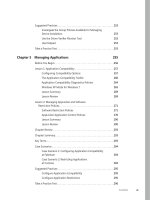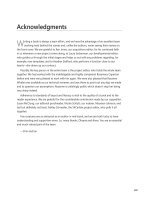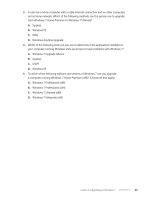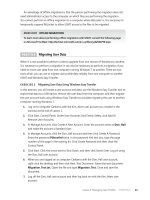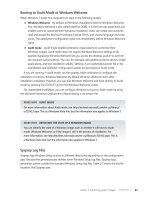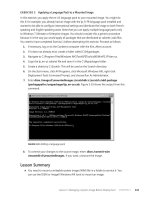Configuring Windows 7 (Training Kit) - Part 71 pps
Bạn đang xem bản rút gọn của tài liệu. Xem và tải ngay bản đầy đủ của tài liệu tại đây (268.66 KB, 10 trang )
Lesson 1: Monitoring Systems CHAPTER 13 673
Logging and Forwarding Events and Event Subscriptions
As an experienced IT professional, you almost certainly have used Event Viewer and event
logs, and this section discusses these tools only briefly before going on to event forwarding
and event subscriptions, with which you might be less familiar.
Details about event subscriptions can be found in the Subscriptions tab of the event log
Properties dialog box. The General tab of this dialog box gives details such as current log size,
maximum log size, and the action to take when maximum log size is reached. The easiest way
to start Event Viewer is to enter eventvwr in the Start menu Search box.
Event Viewer displays event logs, which are files that record significant events on
a computer—for example, when a user logs on or when a program encounters an error.
You will find the details in event logs helpful when troubleshooting problems. The events
recorded fall into the following categories:
n
Critical
n
Error
n
Warning
n
Information
The security log contains two more event categories, Audit Success and Audit Failure, that
are used for auditing purposes.
Event Viewer tracks information in several different logs. Windows logs include the
following:
n
Application Stores program events. Events are classified as error, warning, or
information, depending on the severity of the event. The critical error classification is
not used in the Application log.
n
Security Stores security-related audit events that can be successful or failed.
For example, the security log will record an audit success if a user trying to log on to
the computer was successful.
n
System Stores system events that are logged by Windows 7 and system services.
System events are classified as critical, error, warning, or information.
n
Forwarded Events Stores events that are forwarded by other computers.
Custom Views
You can create custom views by clicking Create Custom View on the Event Viewer Action
menu, specifying the source logs or events and filtering by level, time logged, event ID, task
category, keywords, user, or computer. You are unlikely to specify all these criteria, but this
facility enables you to refine your search to where you think a problem might be occurring
rather than searching through a very large number of events. Figure 13-20 shows a custom
view specification.
6 7 4 CHAPTER 13 Monitoring and Performance
FIGURE 13-20 Specifying a custom view
A filter is not persistent. If you set up a filter to view specific information in an event
log, you need to configure the same filter again the next time you want to see the same
information. Custom views are persistent, which means you can access them whenever
you open Event Viewer. You can save a filter as a custom view so it becomes persistent and
you do not need to configure it for each use. The Action menu also allows you to import
custom views from another source and to connect to another computer. You need to have
an administrator-level account on that computer.
Applications and Services Logs
Event Viewer provides a number of Applications and Services logs. These include logs for
programs that run on the computer and detailed logs that store information about specific
Windows services. For example, these logs can include the following:
n
Hardware Events
n
Internet Explorer
n
Key Management Service
n
Media Center
n
A large number of Microsoft Windows logs
n
Microsoft Office Diagnosis
n
Microsoft Office Sessions
n
Windows PowerShell
Lesson 1: Monitoring Systems CHAPTER 13 675
Attaching Tasks to Events
Sometimes you want to be notified by e-mail if a particular event occurs, or you might want
a specified program to start, such as one that activates a pager. Typically, you might want an
event in the Security log—such as a failed logon, or a successful logon by a user who should
not be able to log on to a particular computer—to trigger this action. To implement this
functionality, you attach a task to the event so that you receive a notification.
To do this, open Event Viewer and navigate to the log that contains the event about which
you want to be notified. Typically, this would be the Security log in Windows logs, but you can
implement this in other Windows logs or in Applications and Services logs if you want to. You
click the event and click Action, click the event and go to the Actions pane, or right-click the
event. You then select Attach Task To This Event.
This opens the Create A Basic Task Wizard. You name and describe the task and then
click Next. The next screen summarizes the event, and you can check that you have chosen
the correct event before clicking Next. The next screen gives you the option of starting
a program, sending an e-mail, or specifying a message. When you make your choice and click
Next, you configure the task. For example, if you want to send an e-mail, you would specify
source address, destination address, subject, task, attachment (if required), and Simple Mail
Transfer Protocol (SMTP) server. You click Next and then click Finish.
Using Network Diagnostics with Event Viewer
When you run Windows Network Diagnostics, as described in Chapter 6, any problem found,
along with solution or solutions, is displayed in the Network Diagnostics dialog box. If,
however, more detailed information about the problem and potential solutions is available,
Windows 7 saves this in one or more event logs. You can use the information in the event logs
to analyze connectivity problems or help interpret the conclusions.
You can filter for network diagnostics and Transmission Control Protocol/Internet Protocol
(TCP/IP) events by specifying (for example) Tcpip and Tcpiv6 event sources and capturing
events from these sources in a custom view.
If Network Diagnostics identifies a problem with a wireless network, it saves information
in the event logs as either helper class events or informational events. Helper class events
provide a summary of the diagnostics results and repeat information displayed in the Network
Diagnostics dialog box. They can also provide additional information for troubleshooting, such
as details about the connection that was diagnosed, diagnostics results, and the capabilities of
the wireless network and the adapter being diagnosed.
Informational events can include information about the connection that was diagnosed,
the wireless network settings on the computer and the network, visible networks and routers
or access points in range at the time of diagnosis, the computer’s preferred wireless network
list, connection history, and connection statistics—for example, packet statistics and roaming
history. They also summarize connection attempts, list their status, and tell you what phases
of the connection failed or did not start.
6 7 6 CHAPTER 13 Monitoring and Performance
Event Forwarding and Event Subscriptions
Event forwarding enables you to transfer events that match specific criteria to an administrative
(or collector) computer. This enables you to manage events centrally. A single event log on the
collector computer holds important events from computers anywhere in your organization.
You do not need to connect to the local event logs on individual computers.
Event forwarding uses Hypertext Transfer Protocol (HTTP) or, if you need to provide
an additional encryption and authentication layer for greater security, Hypertext Transfer
Protocol Secure (HTTPS) to send events from a source computer to a collector computer.
Because event forwarding uses the same protocols that you use to browse Web sites, it works
through most firewalls and proxy servers. Event forwarding traffic is encrypted whether it
uses HTTP or HTTPS.
To use event forwarding, you must configure both the source and collector computers.
On both computers, start the Windows Remote Management (WinRM) and the Windows
Event Collector services. On the source computer, configure a Windows Firewall exception
for the HTTP protocol. You might also need to create a Windows Firewall exception on the
collector computer, depending on the delivery optimization technique you choose.
You can configure collector-initiated or source-initiated subscriptions. In collector-initiated
subscriptions, the collector computer retrieves events from the computer that generated the
event. You would use a collector-initiated subscription when you have a limited number of
source computers and these are already identified. In this type of subscription, you configure
each computer manually.
Subscriptions
In a source-initiated subscription (sometimes termed a source computer–initiated subscription),
the computer on which an event is generated (the source computer) sends the event to the
collector computer. You would use a source-initiated subscription when you have a large
number of source computers and you configure these computers through Group Policy.
In a source-initiated subscription, you can add additional source computers after the
subscription is established and you do not need to know immediately which computers
in your network are to be source computers. In collector-initiated subscriptions, the
collector computer retrieves events from one or more source computers. Collector-initiated
subscriptions are typically used in small networks. In source-initiated subscriptions, the source
computers forward events to the collector computer. Enterprise networks use source-initiated
subscriptions.
A collector computer needs to run Windows Server 2008 R2, Windows Server 2008,
Windows 7, Windows Vista, or Windows Server 2003 R2. A source computer needs to
run Windows XP with SP2, Windows Server 2003 with SP1 or SP2, Windows Server 2003 R2,
Windows Vista, Windows 7, Windows Server 2008, or Windows Server 2008 R2.
Lesson 1: Monitoring Systems CHAPTER 13 677
note FORWARDING COMPUTERS
Much of the literature on this subject uses the term forwarding computer rather than
source computer, sometimes inaccurately. In collector-initiated subscriptions, the collector
computer retrieves events from the source computer. The source computer does not
forward events. Only in source-initiated subscriptions does the source computer forward
events and can accurately be called a forwarding computer. To prevent confusion, the term
source computer, rather than forwarding computer, is used throughout this chapter.
In a collector-initiated subscription, you first manually configure one or more source
computers and the collector computer. When the source computers and the collector
computer are configured, you can create an event subscription to determine what events
should be transferred.
Configuring a Collector-Initiated Subscription
To configure a computer running Windows 7 so that a collector computer can retrieve events
from it, open an elevated command prompt and use the Winrm (Windows Remote Management)
command-line tool to configure the WinRM service by entering the following command:
winrm quickconfig
You can abbreviate this to winrm qc. Windows displays a message similar to that shown
in Figure 13-21. The changes that must be made depend on how the operating system is
configured. You enter Y to make these changes. Note that if any of your network connector
types is set to public, you must set it to private for this command to work.
FIGURE 13-21 Configuring the WinRM service
Next, add the computer account of the collector computer to the local Event Log Readers
group or the local Administrators group on the source computer. You can do this by using
the Local Users And Groups MMC snap-in or by entering a net command in an elevated
command prompt.
6 7 8 CHAPTER 13 Monitoring and Performance
You can add the collector computer account to the local Administrators group or the Event
Log Readers group on the source computer. If you do not require the collector computer
to retrieve events in Security Event logs, it is considered best practice to use the Event Log
Readers group. However, if you do need to transfer Security Event log information, you must
use the local Administrators group.
By default, the Local Users And Groups MMC snap-in does not permit you to add
computer accounts. You must click the Object Types button in the Select Users, Computers,
Or Groups dialog box and select the Computers check box. You can then add computer
accounts.
To configure a computer running Windows 7 to collect events, open an elevated command
prompt and enter the following command to configure the Windows Event Collector service:
wecutil qc
When you have configured the source and collector computers, you next configure the
event subscription by specifying what events the collector computer needs to retrieve and the
event sources (specifically the source computers) from which it must retrieve them.
eXaM tIP
Distinguish between Winrm and Wecutil. Winrm is used to configure WinRM and is
typically used on the source computer. Wecutil is used to configure the Windows Event
Collector service and is typically used on the collector computer.
Configuring a Source-Initiated Subscription
Source-initiated subscriptions are typically used in enterprise networks in which you can use
Group Policy to configure a number of source computers. To configure a source-initiated
subscription, you configure the collector computer manually and then use Group Policy to
configure the source computers. When the collector computer and source computers are
configured, you can create an event subscription to determine which events are forwarded.
Source-initiated subscriptions (sometimes termed source computer–initiated subscriptions)
enable you to configure a subscription on a collector computer without defining the event
source computers. You can then set up multiple remote event source computers by using
Group Policy to forward events to the event collector computer. By contrast, in the collector-
initiated subscription model, you must define all the event sources in the event subscription.
To configure the collector computer in a source-initiated subscription, you need to use
command-line commands entered in an elevated command prompt. If the collector and
source computers are in the same domain, you must create an event subscription Extensible
Markup Language (XML) file (called, for example, Subscription.xml) on the collector computer,
open an elevated command prompt on that computer, and configure WinRM by entering the
following command:
winrm qc -q
Lesson 1: Monitoring Systems CHAPTER 13 679
Configure the Event Collector service on the same computer by entering the following
command:
wecutil qc -q
Create a source-initiated subscription on the collector computer by entering the following
command:
wecutil cs configuration.xml
To configure a source computer to use a source-initiated subscription, you first configure
WinRM on that computer by entering the following command:
winrm qc –q
You then use Group Policy to add the address of the event collector computer to the
SubscriptionManager setting. From an elevated command prompt, start Group Policy by
entering the following command:
%SYSTEMROOT%\System32\gpedit.msc
In Local Group Policy Editor, under Computer Configuration, expand Administrative
Templates, expand Windows Components, and select Event Forwarding. Note that you do not
have this option if you have already configured your computer as a collector computer.
Right-click the SubscriptionManager setting and select Properties. Enable the
SubscriptionManager setting and then click Show. Add at least one setting that specifies the
event collector computer. The SubscriptionManager Properties window contains an Explain
tab that describes the syntax for the setting.
After the SubscriptionManager setting has been added, run the following command to
ensure that the policy is applied:
gpupdate /force
Creating an Event Subscription
To receive events transferred from a source computer to a collector computer, you must
create one or more event subscriptions. Before setting up a subscription, configure both
the collector and source computers as previously described. To create a subscription on
a collector computer, perform the following procedure:
1. In Event Viewer, right-click Subscriptions and select Create Subscription.
2. If prompted, click Yes to configure the Windows Event Collector Service to start
automatically.
3. In the Subscription Properties dialog box shown in Figure 13-22, type a name for the
subscription. You can also type a description if you want.
4. Select and configure the type of subscription you want to create—Collector Initiated
or Source Computer Initiated. Specify Computers or Computer Groups.
6 8 0 CHAPTER 13 Monitoring and Performance
FIGURE 13-22 The Subscription Properties dialog box
5. Click the Select Events button in the Subscription Properties dialog box to open the
Query Filter dialog box. Use this dialog box to define the criteria that forwarded events
must match. Then click OK.
6. If you want, you can click the Advanced button in the Subscription Properties dialog
box to open the Advanced Subscription Settings dialog box. You can configure three
types of subscriptions: Normal, Minimize Bandwidth, and Minimize Latency.
note SPECIFYING THE ACCOUNT THE SUBSCRIPTION USES
Use the Advanced Subscription Settings dialog box to configure the account the subscription
uses. Whether you use the default Machine Account setting or specify a user, you must ensure
that the account is a member of the source computer’s Event Log Readers group (or, if you are
collecting Security Event log information, the local Administrators group).
7. Click OK in the Subscription Properties dialog box to create the subscription.
Practice Using Performance Monitor to Generate a Snapshot of Disk
Performance Data
In this practice, you take a snapshot of performance data on your Canberra computer. You
then view this data in graph, histogram, and report format. You will probably obtain different
results from the Canberra computer in your practice network. Before you carry out this
practice, connect a second storage device, such as a second hard disk or USB flash memory,
to your computer.
Lesson 1: Monitoring Systems CHAPTER 13 681
exercise 1 Add and Monitor Disk Counters
In this exercise, you add counters that enable you to monitor the performance of your system
(C:) hard disk volume. If you have additional volumes on a single hard disk or additional hard
disks on your system, you can extend the exercise to monitor them as well.
note DIskPerf
Both logical and physical disk performance counters are enabled on demand by default
on Windows 7. The Diskperf command still exists, and you can use it to enable or disable
disk counters forcibly for older applications that use ioctl_disk_performance to retrieve raw
counters.
More Info THE Ioctl_DIsk_Performance FILE
For more information about Ioctl_disk_performance, see />library/ms804569.aspx. Note, however, that this is an older feature and is unlikely to be
tested in the 70-680 examination.
A bottleneck affecting disk usage and speed has a significant impact on a computer’s
overall performance. To add counters that monitor disk performance, perform the following
procedure:
1. Log on to the Canberra computer using the Kim_Akers account.
2. Open Performance Monitor.
3. In Performance Monitor, click the Add button (the green + symbol).
4. In the Add Counters dialog box, ensure that Local Computer is selected in the Select
Counters From Computer drop-down list.
5. Select the Show Description check box.
6. Select any counters currently listed in the Added Counters pane and click Remove.
7. In the Counter Selection pane, expand LogicalDisk and select % Free Space. In the
Instances Of Dialog Box pane, select C:, as shown in Figure 13-23. The LogicalDisk\%
Free Space counter measures the percentage of free space on the selected logical disk
drive. If this falls below 15 percent, you risk running out of free space for the operating
system to store critical files.
8. Click Add to add this counter.
9. In the Counter Selection pane, expand PhysicalDisk and select % Idle Time. In the
Instances Of Dialog Box pane, select C:, as shown in Figure 13-24. This counter measures
the percentage of time the disk was idle during the sample interval. If this value falls
below 20 percent, the disk system is said to be saturated, and you should consider
installing a faster disk system.
10. Click Add to add this counter.
6 8 2 CHAPTER 13 Monitoring and Performance
FIGURE 13-23 Selecting the Logical Disk\% Free Space Counter for the C: drive
FIGURE 13-24 Selecting the Physical Disk\% Idle Time Counter for the C: drive

